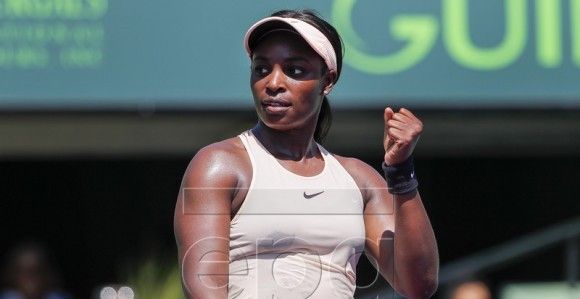WTA • MIAMI OPEN TENNIS • SLOANE STEPHENS BEATS ANGIE KERBER EASILY
Sloane Stephens of the US reacts after defeating Garbine Muguruza of Spain during a fourth round match at the Miami Open tennis tournament on Key Biscayne, Miami, Florida, USA, 26 March 2018. EPA-EFE/ERIK S. LESSER
By Craig Cignarelli
There are billions of moves in chess. However, a couple of strategies tend to dominate high level competition. There is the positional game, playing with whatever pieces exist and trying to find the best move therein, and the tactical game, which is intended to set up attacks to place the opponent in jeopardy. That is a rudimentary explanation but it will suffice.
I took a few minutes off the court today to catch the Stephens-Kerber match. These are two slam winners battling in the quarters of the Miami Open. Stephens seems to be more in form these days, moving the ball better and moving herself even better than that. Kerber is a tactical player, setting up her patterns and looking to finish with her weapons. Conversely, Stephens is more of a positional player, taking what Kerber throws at her and defending with the right shot for that situation.
Today, Stephens’ ability to counter with speed and depth placed Kerber in a no-win situation. When Stephens movement is flowing this well, it is very difficult to get the ball by her, and when she is striking with such depth and pace, it leaves her opponent with few options. At present, Kerber’s toolbox is not deep enough. She let Sloane play in her comfort zone – waist high and with pace. She neglected to make Stephens play from a different part of the court, she rarely rushed her opponent, and she displayed less variety than a McDonalds menu. Stephens dominated the two-time slam winner 6-1, 6-2.
Lesson: Learning to play positionally or tactically is important. Are you the type of personality and athlete who wants to impose your will upon your opponent, or do you prefer seeking out the shots that make your opponent uncomfortable? Answering this question will aid your development as a player. But you need to know which game you are playing.
Angelique Kerber of Germany in action against Sloane Stephens of the US during a quarter final round match at the Miami Open tennis tournament on Key Biscayne, Miami, Florida, USA, 27 March 2018. EPA-EFE/ERIK S. LESSER
Sloane Stephens of the US in action against Angelique Kerber of Germany during a quarter final round match at the Miami Open tennis tournament on Key Biscayne, Miami, Florida, USA, 27 March 2018. EPA-EFE/ERIK S. LESSER
Topics: 10sballs, Angelique Kerber, Craig Cignarelli, Kerber vs Stephens, Miami Open 2018, Miami Open tennis, Sloane Stephens, Sports, Tennis, Tennis News, Wta


10sBalls Top Stories
- Bahis Sitelerinin Deneme Bonusu Kullanım Şartları
- Deneme Bonusları ile Ücretsiz Bahis Nasıl Yapılır?
- Cazip Hoş Geldin Bonusları ile Üyelik Avantajları
- Bahis Siteleri ve İlk Üyelik Bonusu Detayları
- Yeni Üyeler İçin En Cazip Bahis Bonusu
- Deneme Bonusları İle Eğlenceli Oyun Deneyimleri
- Güvenilir Bahis Siteleri: Bonus ve Güvenlik İncelemesi
- Reasons Behind the Increase in Sex Shops
- Reasons Behind the Increase in Sex Shops
- Reasons Behind the Increase in Sex Shops
- Casibom: Yaşayan Casinolar ve Bahisler Lider Platform
- Sea Star Casino: Play Games Without Registering Online
- JETZT DEN SWEET BONANZA SLOT GRATIS DREHEN
- Азартные игры с Мостбет Казино – испытайте удачу
- Çevrimiçi en iyi yuvalar: Hizmetinizde Karavan Bet Casino





 WTA • MIAMI OPEN TENNIS • SLOANE STEPHENS BEATS ANGIE KERBER EASILY
WTA • MIAMI OPEN TENNIS • SLOANE STEPHENS BEATS ANGIE KERBER EASILY
